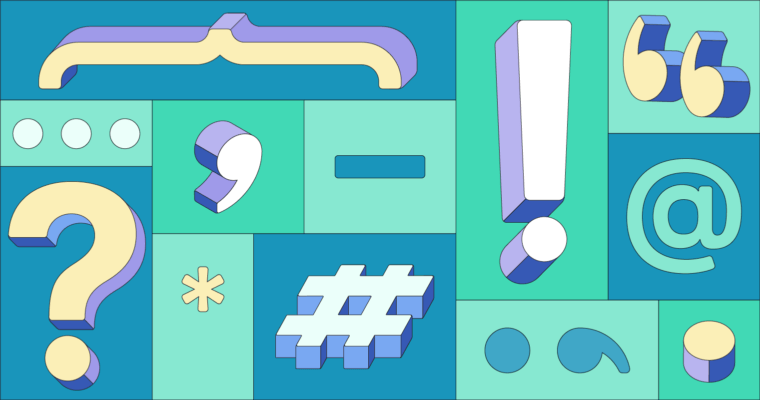
Apostrophes can be tricky. Sometimes they form possessives. Sometimes they form contractions. Can they ever make something plural?
Apostrophe use: Contractions and omissions
A contraction is a shortened form of a word or group of words that omits certain letters or sounds. In a contraction, an apostrophe represents missing letters. The most common contractions are made up of verbs, auxiliaries, or modals attached to other words: “He would” = “He’d.” “I have” = “I’ve.” “They are” = “They’re.” “You cannot” = “You can’t.”
Some writers use less common contractions when they want to represent a particular style of speech. They might write somethin’ to represent the way people often don’t pronounce the final g of something in speech. Occasionally, you might see e’er (instead of ever) in poetry. And, of course, in the American South, you will probably encounter y’all (you all). Decade names are often contracted as well: the ’60s (the 1960s).
| Contraction | Uncontracted | Examples |
| -n’t | not | Isn’t (is not), hasn’t (has not) |
| -’re | are | They’re (they are), we’re (we are), you’re (you are) |
| -’d | had, would | She’d (she had, she would), I’d (I had, I would) |
| -’ll | will | We’ll (we will), you’ll (you will) |
| -’s | is | He’s (he is), it’s (it is) |
| I’m | I am | — |
| let’s | let us | — |
Contractions are usually considered to be relatively casual. If you’re writing something very formal, you may want to avoid using them except in cases like o’clock, where the full phrase (of the clock) truly is rare.
Apostrophes and possessive nouns
The rules about forming possessive nouns probably cause the most apostrophe confusion. They vary a bit, depending on what type of noun you are making into a possessive. Here are the rules of thumb:
For most singular nouns, add -’s:
For most plural nouns, add only an apostrophe:
For plural nouns that do not end in s, add -’s:
Style guides vary in their recommendations of what to do to make a singular proper noun that ends in s possessive. Some recommend adding only an apostrophe:
Others say to add -’s:
No matter which style you use, add only the apostrophe to plural proper nouns that end in s:
Use whichever style matches the style guide you use for your writing. If you don’t have a style guide, it’s OK to just pick one of the methods, as long as you don’t switch back and forth within the same document.
Apostrophes and possessive pronouns
Personal pronouns, unlike regular nouns, do not use apostrophes to form possessives. Most writers don’t have trouble with the possessive pronouns my, mine, his, her, and our. It’s your, yours, hers, its, ours, their, and theirs that tend to cause the confusion. The relative possessive pronoun whose is also frequently the victim of apostrophe abuse. Note that none of these forms use an apostrophe. In fact, for some of these pronouns, adding an apostrophe forms a contraction instead of a possessive (see the table above).
| Pronoun | Possessive Pronoun | Absolute (Independent) Form |
| me | my | mine |
| you | your | yours |
| he | his | his |
| her | her | hers |
| it | its | — |
| we | our | ours |
| them | their | theirs |
| who | whose | — |
Apostrophes and joint possession
What do you do with the apostrophe when you’re talking about things that belong to more than one person? When one thing belongs to two or more people jointly, make only the final name possessive:
When you’re talking about separate things that belong to different people but you’re discussing the things together, make all the names possessive:
Using possessive personal pronouns in joint constructions often sounds awkward (You have their and my gratitude). Usually, the best solution is to rephrase the sentence to avoid the joint construction (You have our gratitude or You have their gratitude and mine).
Apostrophes and plurals
Using an unnecessary apostrophe to form the plural of a noun is a very common mistake. Sometimes, it’s called the grocer’s apostrophe because of how frequently it is spotted in grocery store advertisements (3 orange’s for $1!). Don’t do it! With very few exceptions, apostrophes do not make nouns plural.
The one notable exception to this rule is the plural form of lowercase letters, which are formed with an apostrophe to prevent misreading:
Apostrophes with surrounding punctuation
An apostrophe is part of the word it belongs to, so it should not be separated from that word by a period, a comma, a question mark, or any other punctuation mark.
In the second example, take note of the apostrophe at the beginning of ’twas. Apostrophes that fall at the beginning of a contraction are often mistyped as left-hand single quotation marks, when the apostrophe is actually identical to the right-hand single quotation mark. Word processors tend to do this by default, as they assume you are beginning a quote. Keep this in mind, especially when you are writing about specific decades, such as the ’60s or the ’90s.
When to check a style guide
Sooner or later, you’ll come across a phrase that sounds fine out loud but looks weird on paper because of apostrophes. Do’s and don’ts? Dos and don’ts? Do’s and don’t’s? For cases like these, it’s best to check a comprehensive style guide, such as The Chicago Manual of Style or the The Associated Press Stylebook (it’s do’s and don’ts, according to AP). A good dictionary may also be able to offer you some guidance. If you can’t find a precedent, it’s probably best to use a different word or phrase; unduly creative apostrophe use will inevitably distract your readers.






